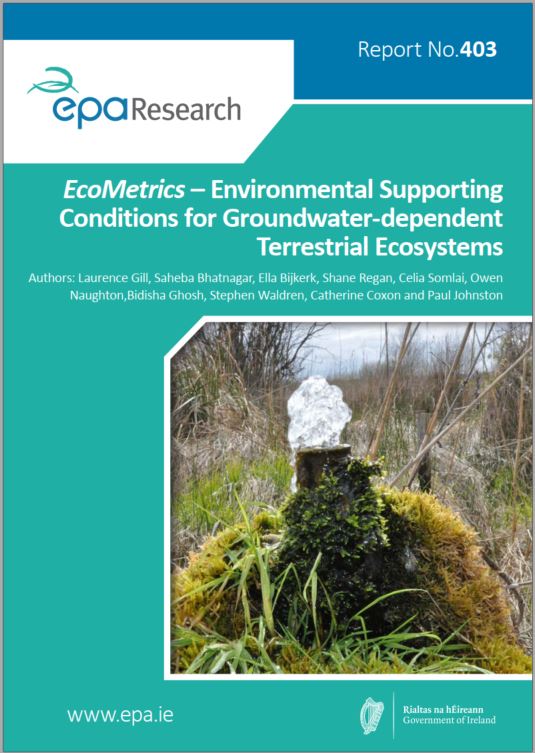Research 403: EcoMetrics – Environmental Supporting Conditions for Groundwater-dependent Terrestrial Ecosystems
Authors: Laurence Gill, Saheba Bhatnagar, Ella Bijkerk, Shane Regan, Celia Somlai, Owen Naughton, Bidisha Ghosh, Stephen Waldren, Catherine Coxon and Paul Johnston
Summary: Wetlands provide important regulating ecosystem services, such as water purification, carbon capture and storage, and flood protection. They also provide rich habitats for biodiversity, including many protected species. This research project evaluated and developed methods for the assessment and definition of appropriate ecohydrological metrics to help policymakers conserve and/or restore wetlands, particularly with respect to meeting the objectives of the Water Framework Directive and Habitats Directive as applied to GWDTEs in Ireland.

Identifying Pressures
Wetlands provide important regulating ecosystem services, such as water purification, carbon capture and storage, and flood protection. They also provide rich habitats for biodiversity, including many protected species. Understanding the hydrology of wetland systems is essential for successful management. Many of the world’s wetland ecosystems have experienced significant degradation; many have been removed, while others are under threat as a result of proximal land degradation, water quality pollutant impacts and/or water supply pressures (caused by drainage, etc.). Wetland habitats in Ireland present a diverse array of ecosystems, ranging from upland and low-lying ombrotrophic bogs and groundwater-fed fens to ephemeral karst groundwater lakes (turloughs). The ecology of groundwater-dependent terrestrial ecosystems (GWDTEs) is fundamentally reliant on the supporting hydrogeology. The nature of groundwater dependency in these wetlands differs distinctly with respect to quality, level and contribution/duration (and combinations thereof), and these have been identified as key metrics of environmental supporting conditions for GWDTEs. This study focused on raised bogs, turloughs and fens, and sought to identify appropriate metrics that characterise their environmental supporting conditions by evaluating a combination of existing data and, where required, some additional field study. In addition, there was an overarching work package that focused on the use of remote sensing (RS) techniques to monitor changes in the ecohydrological health of wetlands.
Informing Policy
This research project evaluated and developed methods for the assessment and definition of appropriate ecohydrological metrics to help policymakers conserve and/or restore wetlands, particularly with respect to meeting the objectives of the Water Framework Directive and Habitats Directive as applied to GWDTEs in Ireland. The research showed that water level duration envelopes can be clearly associated with required hydrological conditions for the ecological health of different wetland vegetation communities and defined such envelopes for the three wetland types studied (raised bogs, calcareous fens and turloughs). The research also investigated water quality dynamics within such wetlands, revealing that they are more complex than water level dynamics and involve the accumulation and internal cycling of nutrients. Hence, at this stage, clear thresholds cannot be confidently defined without carrying out additional targeted studies and more continual monitoring of such wetlands. Finally, the research developed a new nested drone–satellite RS methodology, which can be adopted as a tool for continual monitoring of wetland health.
Developing Solutions
This research project advanced the methods of the assessment and definition of appropriate ecohydrological metrics that can be applied to GWDTEs in Ireland. It provides a template for co-ordinated field monitoring in parallel to the implementation of RS mapping to assess the ecological health of GWDTEs. This needs to be set up and implemented by the relevant state/semi-state organisations responsible for the protection and/or restoration of GWDTEs. The research findings suggest that the nested drone–satellite RS methodology can be adopted as the ideal solution for the continual monitoring of wetland health. In addition, the study showed that it is possible to monitor the vegetation communities on these wetlands up to a reasonable level of accuracy using freely available satellite data, in particular those from Sentinel-2. Additional fens need to be monitored to add to the database and to help strengthen the findings over a wider range of wetland sites with different pressures. The research recommends that more focus should be placed on the link between the wider supporting catchment groundwater metrics and those defined in the wetlands for different vegetation types. Equally, in terms of water quality, it recommends that more long-term monitoring, particularly of fens and turloughs, is needed before the real impact and source of pollutants can be quantified and targeted.
https://www.epa.ie/media/epa-2020/research/epa-funded-research/Report-cover-403.jpg